Heat Transfer PowerPoint PPT Presentation
1 / 16
Title: Heat Transfer
1
Heat Transfer
- Conduction, Convention and Radiation
2
Principles of Heat Transfer
- Heat transfer is one way of transferring energy
to a body (work is the other) - Occurs only when there is a temperature
difference between the two bodies (heat flows
from hot to cold) - Occurs through three processes conduction,
convection, and radiation
3
From Hot to Cold
- Heat energy is transferred when there is a
difference in temperature - In an isolated system heat flows from hot to cold
until both bodies are at the same temperature
4
The Three Types of Heat Transfer
- Conduction Heat is transferred through a
material (e.g. insulation or glass) - Convection Heat is transferred by air or water
currents (e.g. ocean currents) - Radiation Heat is transferred when a hot body
emits radiation (e.g. infrared radiation given
off by a fire)
5
Conduction
- Conduction depends on the following
- Type of Material thermal conductivity (e.g.
metal spoons transfer heat better than plastic) - Temperature Difference
- Area (e.g. a thin stirring stick transfers less
heat than a thick spoon) - Thickness (the distance heat has to travel)
6
Heat Conduction Equation
- QC/t heat transferred per unit of time
- c thermal conductivity
- A area
- T2 - T1 temperature difference
- ? thickness
7
Examples of Conduction
- Why does crushed ice melt faster than ice cubes?
- Answer Because the exposed area is larger
- Why do you save money by turning down the
thermostat in cold weather? - Answer Because the temperature difference
(between inside and outside) is smaller
8
Convection
- Warm air (water) rises and cool air (water) sinks
- Why? Because warm air (water) is less dense and
floats on cooler air (water) - The rising of warm air (water) creates
circulating convection currents - Convection can occur in any gas or fluid
9
Examples of Convection
- The sea breeze is caused by differences in
temperature between the ocean and the shore - In fact, all weather and ocean currents are
caused by convection - A draft in a cold room is caused by convection
currents from air leaking through a window or
door - A rolling boil in a pot is the result of
convection
10
Radiation
- Radiation results in heat being emitted at the
speed of light - Radiated heat requires no medium (e.g. air) and
can propagate through empty space - Heat is emitted as electromagnetic radiation
(e.g. light) - Here, radiation does not refer to the emissions
of radioactive substances
11
The Wave Nature of Light
- Light is a form of electromagnetic radiation
- Electromagnetic radiation consists of waves of a
definite wavelength - Wavelength is the distance from one crest to the
next
12
The Speed of Light
- All electromagnetic waves travel at the speed of
light - The speed of light is 186,000 miles/second or 3 x
108 m/s - Light can travel around the earth about 7 times
in one second
13
The Electromagnetic Spectrum
- Radio, Microwave, Infrared, Visible Light,
Ultraviolet, X-Rays and Gamma Rays are all
electromagnetic radiation - Only ultraviolet, x-rays and gamma rays are
harmful to our cells
14
Radiation from Hot Objects
- Hot objects emit radiation over a wide range of
wavelengths - Room temperature objects emit radiation that is
mostly infrared - Object hotter than 1000 C begin to emit visible
light
Light from the Sun
15
Examples of Radiation
- A hot burner on a stove or a fire emits large
amounts of infrared and a smaller amount of
visible radiation - Mammals (40 C) emit mostly infrared radiation
- Our sun (6000 C) emits a large amount of
visible light - Incandescent lights (regular light bulbs) have
heated filaments that emit visible light
16
An Example of Heat Transfer
- A radiator works by circulating steam through a
series of pipes, where it condenses and releases
heat - Heat is transferred by conduction, convection,
and radiation

